- Java锁的逻辑(结合对象头和ObjectMonitor)
- 还在用饼状图?来瞧瞧这些炫酷的百分比可视化新图形(附代码实现)⛵
- 自动注册实体类到EntityFrameworkCore上下文,并适配ABP及ABPVNext
- 基于Sklearn机器学习代码实战
赛题以金融风控中的个人信贷为背景,要求选手根据贷款申请人的数据信息预测其是否有违约的可能,以此判断是否通过此项贷款,这是一个典型的分类问题。通过这道赛题来引导大家了解金融风控中的一些业务背景,解决实际问题,帮助竞赛新人进行自我练习、自我提高.
赛题以预测金融风险为任务,数据集报名后可见并可下载,该数据来自某信贷平台的贷款记录,总数据量超过120w,包含47列变量信息,其中15列为匿名变量。为了保证比赛的公平性,将会从中抽取80万条作为训练集,20万条作为测试集A,20万条作为测试集B,同时会对employmentTitle、purpose、postCode和title等信息进行脱敏.
比赛地址: https://tianchi.aliyun.com/competition/entrance/531830/introduction 。
赛题以预测用户贷款是否违约为任务,数据集报名后可见并可下载,该数据来自某信贷平台的贷款记录,总数据量超过120w,包含47列变量信息,其中15列为匿名变量。为了保证比赛的公平性,将会从中抽取80万条作为训练集,20万条作为测试集A,20万条作为测试集B,同时会对employmentTitle、purpose、postCode和title等信息进行脱敏.
一般而言,对于数据在比赛界面都有对应的数据概况介绍(匿名特征除外),说明列的性质特征。了解列的性质会有助于我们对于数据的理解和后续分析。 Tip:匿名特征,就是未告知数据列所属的性质的特征列.
train.csv 。
竞赛采用AUC作为评价指标。AUC(Area Under Curve)被定义为 ROC曲线 下与坐标轴围成的面积.
1、混淆矩阵(Confuse Matrix) 。
2、准确率(Accuracy) 准确率是常用的一个评价指标,但是不适合样本不均衡的情况。 $Accuracy = \frac{TP + TN}{TP + TN + FP + FN}$ 。
3、精确率(Precision) 又称查准率,正确预测为正样本(TP)占预测为正样本(TP+FP)的百分比。 $Precision = \frac{TP}{TP + FP}$ 。
4、召回率(Recall) 又称为查全率,正确预测为正样本(TP)占正样本(TP+FN)的百分比。 $Recall = \frac{TP}{TP + FN}$ 。
5、F1 Score 精确率和召回率是相互影响的,精确率升高则召回率下降,召回率升高则精确率下降,如果需要兼顾二者,就需要精确率、召回率的结合F1 Score。 $F1-Score = \frac{2}{\frac{1}{Precision} + \frac{1}{Recall}}$ 。
6、P-R曲线(Precision-Recall Curve) P-R曲线是描述精确率和召回率变化的曲线 。

7、ROC(Receiver Operating Characteristic) 。
TPR:在所有实际为正例的样本中,被正确地判断为正例之比率。 $TPR = \frac{TP}{TP + FN}$ FPR:在所有实际为负例的样本中,被错误地判断为正例之比率。 $FPR = \frac{FP}{FP + TN}$ 。
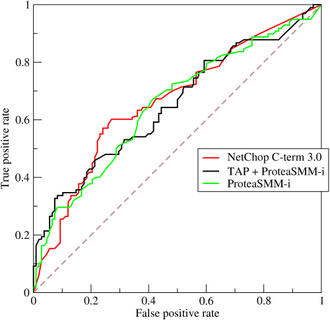
8、AUC(Area Under Curve) AUC(Area Under Curve)被定义为 ROC曲线 下与坐标轴围成的面积,显然这个面积的数值不会大于1。又由于ROC曲线一般都处于y=x这条直线的上方,所以AUC的取值范围在0.5和1之间。AUC越接近1.0,检测方法真实性越高;等于0.5时,则真实性最低,无应用价值.
1、KS(Kolmogorov-Smirnov) KS统计量由两位苏联数学家A.N. Kolmogorov和N.V. Smirnov提出。在风控中,KS常用于评估模型区分度。区分度越大,说明模型的风险排序能力(ranking ability)越强。 K-S曲线与ROC曲线类似,不同在于 。
| KS(%) | 好坏区分能力 |
|---|---|
| 20以下 | 不建议采用 |
| 20-40 | 较好 |
| 41-50 | 良好 |
| 51-60 | 很强 |
| 61-75 | 非常强 |
| 75以上 | 过于高,疑似存在问题 |
2、ROC 。
3、AUC 。

本部分为对于数据读取和指标评价的示例.
import pandas as pd
train = pd.read_csv('train.csv')
testA = pd.read_csv('testA.csv')
print('Train data shape:',train.shape)
print('TestA data shape:',testA.shape)
Train data shape: (800000, 47)
TestA data shape: (200000, 48)
train.head()
## 混淆矩阵
import numpy as np
from sklearn.metrics import confusion_matrix
y_pred = [0, 1, 0, 1]
y_true = [0, 1, 1, 0]
print('混淆矩阵:\n',confusion_matrix(y_true, y_pred))
混淆矩阵:
[[1 1]
[1 1]]
## accuracy
from sklearn.metrics import accuracy_score
y_pred = [0, 1, 0, 1]
y_true = [0, 1, 1, 0]
print('ACC:',accuracy_score(y_true, y_pred))
ACC: 0.5
## Precision,Recall,F1-score
from sklearn import metrics
y_pred = [0, 1, 0, 1]
y_true = [0, 1, 1, 0]
print('Precision',metrics.precision_score(y_true, y_pred))
print('Recall',metrics.recall_score(y_true, y_pred))
print('F1-score:',metrics.f1_score(y_true, y_pred))
Precision 0.5
Recall 0.5
F1-score: 0.5
## P-R曲线
import matplotlib.pyplot as plt
from sklearn.metrics import precision_recall_curve
y_pred = [0, 1, 1, 0, 1, 1, 0, 1, 1, 1]
y_true = [0, 1, 1, 0, 1, 0, 1, 1, 0, 1]
precision, recall, thresholds = precision_recall_curve(y_true, y_pred)
plt.plot(precision, recall)
[<matplotlib.lines.Line2D at 0x2170d0d6108>]

## ROC曲线
from sklearn.metrics import roc_curve
y_pred = [0, 1, 1, 0, 1, 1, 0, 1, 1, 1]
y_true = [0, 1, 1, 0, 1, 0, 1, 1, 0, 1]
FPR,TPR,thresholds=roc_curve(y_true, y_pred)
plt.title('ROC')
plt.plot(FPR, TPR,'b')
plt.plot([0,1],[0,1],'r--')
plt.ylabel('TPR')
plt.xlabel('FPR')
Text(0.5, 0, 'FPR')

## AUC
import numpy as np
from sklearn.metrics import roc_auc_score
y_true = np.array([0, 0, 1, 1])
y_scores = np.array([0.1, 0.4, 0.35, 0.8])
print('AUC socre:',roc_auc_score(y_true, y_scores))
AUC socre: 0.75
## KS值 在实际操作时往往使用ROC曲线配合求出KS值
from sklearn.metrics import roc_curve
y_pred = [0, 1, 1, 0, 1, 1, 0, 1, 1, 1]
y_true = [0, 1, 1, 0, 1, 0, 1, 1, 1, 1]
FPR,TPR,thresholds=roc_curve(y_true, y_pred)
KS=abs(FPR-TPR).max()
print('KS值:',KS)
KS值: 0.5238095238095237
评分卡是一张拥有分数刻度会让相应阈值的表。信用评分卡是用于用户信用的一张刻度表。以下代码是一个非标准评分卡的代码流程,用于刻画用户的信用评分。评分卡是金融风控中常用的一种对于用户信用进行刻画的手段哦! 。
#评分卡 不是标准评分卡
def Score(prob,P0=600,PDO=20,badrate=None,goodrate=None):
P0 = P0
PDO = PDO
theta0 = badrate/goodrate
B = PDO/np.log(2)
A = P0 + B*np.log(2*theta0)
score = A-B*np.log(prob/(1-prob))
return score
目的:
1.EDA价值主要在于熟悉了解整个数据集的基本情况(缺失值,异常值),对数据集进行验证是否可以进行接下来的机器学习或者深度学习建模. 。
2.了解变量间的相互关系、变量与预测值之间的存在关系.
3.为特征工程做准备 。
import pandas as pd
import numpy as np
import matplotlib.pyplot as plt
import seaborn as sns
import datetime
import warnings
warnings.filterwarnings('ignore')
/Users/exudingtao/opt/anaconda3/lib/python3.7/site-packages/statsmodels/tools/_testing.py:19: FutureWarning: pandas.util.testing is deprecated. Use the functions in the public API at pandas.testing instead.
import pandas.util.testing as tm
以上库都是pip install 安装就好,如果本机有python2,python3两个python环境傻傻分不清哪个的话,可以pip3 install 。或者直接在notebook中'!pip3 install ****'安装.
data_train = pd.read_csv('./train.csv')
data_test_a = pd.read_csv('./testA.csv')
data_train_sample = pd.read_csv("./train.csv",nrows=5)
#设置chunksize参数,来控制每次迭代数据的大小
chunker = pd.read_csv("./train.csv",chunksize=5)
for item in chunker:
print(type(item))
#<class 'pandas.core.frame.DataFrame'>
print(len(item))
#5
data_test_a.shape
(200000, 48)
data_train.shape
(800000, 47)
data_train.columns
Index(['id', 'loanAmnt', 'term', 'interestRate', 'installment', 'grade',
'subGrade', 'employmentTitle', 'employmentLength', 'homeOwnership',
'annualIncome', 'verificationStatus', 'issueDate', 'isDefault',
'purpose', 'postCode', 'regionCode', 'dti', 'delinquency_2years',
'ficoRangeLow', 'ficoRangeHigh', 'openAcc', 'pubRec',
'pubRecBankruptcies', 'revolBal', 'revolUtil', 'totalAcc',
'initialListStatus', 'applicationType', 'earliesCreditLine', 'title',
'policyCode', 'n0', 'n1', 'n2', 'n2.1', 'n4', 'n5', 'n6', 'n7', 'n8',
'n9', 'n10', 'n11', 'n12', 'n13', 'n14'],
dtype='object')
查看一下具体的列名,赛题理解部分已经给出具体的特征含义,这里方便阅读再给一下:
通过info()来熟悉数据类型 。
data_train.info()
<class 'pandas.core.frame.DataFrame'>
RangeIndex: 800000 entries, 0 to 799999
Data columns (total 47 columns):
# Column Non-Null Count Dtype
--- ------ -------------- -----
0 id 800000 non-null int64
1 loanAmnt 800000 non-null float64
2 term 800000 non-null int64
3 interestRate 800000 non-null float64
4 installment 800000 non-null float64
5 grade 800000 non-null object
6 subGrade 800000 non-null object
7 employmentTitle 799999 non-null float64
8 employmentLength 753201 non-null object
9 homeOwnership 800000 non-null int64
10 annualIncome 800000 non-null float64
11 verificationStatus 800000 non-null int64
12 issueDate 800000 non-null object
13 isDefault 800000 non-null int64
14 purpose 800000 non-null int64
15 postCode 799999 non-null float64
16 regionCode 800000 non-null int64
17 dti 799761 non-null float64
18 delinquency_2years 800000 non-null float64
19 ficoRangeLow 800000 non-null float64
20 ficoRangeHigh 800000 non-null float64
21 openAcc 800000 non-null float64
22 pubRec 800000 non-null float64
23 pubRecBankruptcies 799595 non-null float64
24 revolBal 800000 non-null float64
25 revolUtil 799469 non-null float64
26 totalAcc 800000 non-null float64
27 initialListStatus 800000 non-null int64
28 applicationType 800000 non-null int64
29 earliesCreditLine 800000 non-null object
30 title 799999 non-null float64
31 policyCode 800000 non-null float64
32 n0 759730 non-null float64
33 n1 759730 non-null float64
34 n2 759730 non-null float64
35 n2.1 759730 non-null float64
36 n4 766761 non-null float64
37 n5 759730 non-null float64
38 n6 759730 non-null float64
39 n7 759730 non-null float64
40 n8 759729 non-null float64
41 n9 759730 non-null float64
42 n10 766761 non-null float64
43 n11 730248 non-null float64
44 n12 759730 non-null float64
45 n13 759730 non-null float64
46 n14 759730 non-null float64
dtypes: float64(33), int64(9), object(5)
memory usage: 286.9+ MB
总体粗略的查看数据集各个特征的一些基本统计量 。
data_train.describe()
data_train.head(3).append(data_train.tail(3))
查看缺失值 。
print(f'There are {data_train.isnull().any().sum()} columns in train dataset with missing values.')
There are 22 columns in train dataset with missing values.
上面得到训练集有22列特征有缺失值,进一步查看缺失特征中缺失率大于50%的特征 。
have_null_fea_dict = (data_train.isnull().sum()/len(data_train)).to_dict()
fea_null_moreThanHalf = {}
for key,value in have_null_fea_dict.items():
if value > 0.5:
fea_null_moreThanHalf[key] = value
fea_null_moreThanHalf
{}
具体的查看缺失特征及缺失率 。
#nan可视化
missing = data_train.isnull().sum()/len(data_train)
missing = missing[missing > 0]
missing.sort_values(inplace=True)
missing.plot.bar()
<matplotlib.axes._subplots.AxesSubplot at 0x1229ab890>
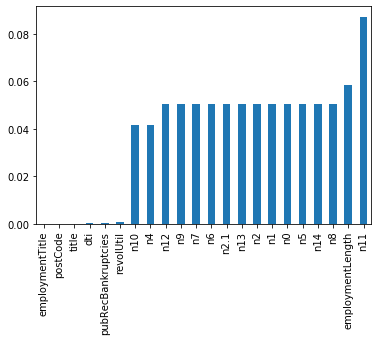
Tips: 比赛大杀器lgb模型可以自动处理缺失值,Task4模型会具体学习模型了解模型哦! 。
查看训练集测试集中特征属性只有一值的特征 。
one_value_fea = [col for col in data_train.columns if data_train[col].nunique() <= 1]
one_value_fea_test = [col for col in data_test_a.columns if data_test_a[col].nunique() <= 1]
one_value_fea
['policyCode']
one_value_fea_test
['policyCode']
print(f'There are {len(one_value_fea)} columns in train dataset with one unique value.')
print(f'There are {len(one_value_fea_test)} columns in test dataset with one unique value.')
There are 1 columns in train dataset with one unique value.
There are 1 columns in test dataset with one unique value.
47列数据中有22列都缺少数据,这在现实世界中很正常。‘policyCode’具有一个唯一值(或全部缺失)。有很多连续变量和一些分类变量.
numerical_fea = list(data_train.select_dtypes(exclude=['object']).columns)
category_fea = list(filter(lambda x: x not in numerical_fea,list(data_train.columns)))
numerical_fea
category_fea
['grade', 'subGrade', 'employmentLength', 'issueDate', 'earliesCreditLine']
data_train.grade
0 E
1 D
2 D
3 A
4 C
..
799995 C
799996 A
799997 C
799998 A
799999 B
Name: grade, Length: 800000, dtype: object
#过滤数值型类别特征
def get_numerical_serial_fea(data,feas):
numerical_serial_fea = []
numerical_noserial_fea = []
for fea in feas:
temp = data[fea].nunique()
if temp <= 10:
numerical_noserial_fea.append(fea)
continue
numerical_serial_fea.append(fea)
return numerical_serial_fea,numerical_noserial_fea
numerical_serial_fea,numerical_noserial_fea = get_numerical_serial_fea(data_train,numerical_fea)
numerical_serial_fea
numerical_noserial_fea
['term',
'homeOwnership',
'verificationStatus',
'isDefault',
'initialListStatus',
'applicationType',
'policyCode',
'n11',
'n12']
data_train['term'].value_counts()#离散型变量
3 606902
5 193098
Name: term, dtype: int64
data_train['homeOwnership'].value_counts()#离散型变量
0 395732
1 317660
2 86309
3 185
5 81
4 33
Name: homeOwnership, dtype: int64
data_train['verificationStatus'].value_counts()#离散型变量
1 309810
2 248968
0 241222
Name: verificationStatus, dtype: int64
data_train['initialListStatus'].value_counts()#离散型变量
0 466438
1 333562
Name: initialListStatus, dtype: int64
data_train['applicationType'].value_counts()#离散型变量
0 784586
1 15414
Name: applicationType, dtype: int64
data_train['policyCode'].value_counts()#离散型变量,无用,全部一个值
1.0 800000
Name: policyCode, dtype: int64
data_train['n11'].value_counts()#离散型变量,相差悬殊,用不用再分析
0.0 729682
1.0 540
2.0 24
4.0 1
3.0 1
Name: n11, dtype: int64
data_train['n12'].value_counts()#离散型变量,相差悬殊,用不用再分析
0.0 757315
1.0 2281
2.0 115
3.0 16
4.0 3
Name: n12, dtype: int64
#每个数字特征得分布可视化
f = pd.melt(data_train, value_vars=numerical_serial_fea)
g = sns.FacetGrid(f, col="variable", col_wrap=2, sharex=False, sharey=False)
g = g.map(sns.distplot, "value")

#Ploting Transaction Amount Values Distribution
plt.figure(figsize=(16,12))
plt.suptitle('Transaction Values Distribution', fontsize=22)
plt.subplot(221)
sub_plot_1 = sns.distplot(data_train['loanAmnt'])
sub_plot_1.set_title("loanAmnt Distribuition", fontsize=18)
sub_plot_1.set_xlabel("")
sub_plot_1.set_ylabel("Probability", fontsize=15)
plt.subplot(222)
sub_plot_2 = sns.distplot(np.log(data_train['loanAmnt']))
sub_plot_2.set_title("loanAmnt (Log) Distribuition", fontsize=18)
sub_plot_2.set_xlabel("")
sub_plot_2.set_ylabel("Probability", fontsize=15)
Text(0, 0.5, 'Probability')

category_fea
['grade', 'subGrade', 'employmentLength', 'issueDate', 'earliesCreditLine']
data_train['grade'].value_counts()
B 233690
C 227118
A 139661
D 119453
E 55661
F 19053
G 5364
Name: grade, dtype: int64
data_train['subGrade'].value_counts()
C1 50763
B4 49516
B5 48965
B3 48600
C2 47068
C3 44751
C4 44272
B2 44227
B1 42382
C5 40264
A5 38045
A4 30928
D1 30538
D2 26528
A1 25909
D3 23410
A3 22655
A2 22124
D4 21139
D5 17838
E1 14064
E2 12746
E3 10925
E4 9273
E5 8653
F1 5925
F2 4340
F3 3577
F4 2859
F5 2352
G1 1759
G2 1231
G3 978
G4 751
G5 645
Name: subGrade, dtype: int64
data_train['employmentLength'].value_counts()
10+ years 262753
2 years 72358
< 1 year 64237
3 years 64152
1 year 52489
5 years 50102
4 years 47985
6 years 37254
8 years 36192
7 years 35407
9 years 30272
Name: employmentLength, dtype: int64
data_train['issueDate'].value_counts()
2016-03-01 29066
2015-10-01 25525
2015-07-01 24496
2015-12-01 23245
2014-10-01 21461
...
2007-08-01 23
2007-07-01 21
2008-09-01 19
2007-09-01 7
2007-06-01 1
Name: issueDate, Length: 139, dtype: int64
data_train['earliesCreditLine'].value_counts()
Aug-2001 5567
Sep-2003 5403
Aug-2002 5403
Oct-2001 5258
Aug-2000 5246
...
May-1960 1
Apr-1958 1
Feb-1960 1
Aug-1946 1
Mar-1958 1
Name: earliesCreditLine, Length: 720, dtype: int64
data_train['isDefault'].value_counts()
0 640390
1 159610
Name: isDefault, dtype: int64
plt.figure(figsize=(8, 8))
sns.barplot(data_train["employmentLength"].value_counts(dropna=False)[:20],
data_train["employmentLength"].value_counts(dropna=False).keys()[:20])
plt.show()
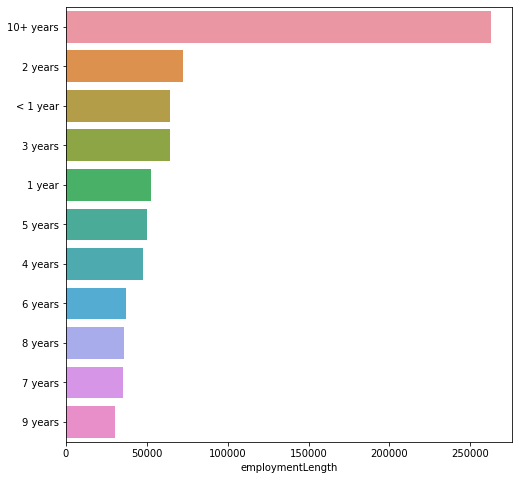
train_loan_fr = data_train.loc[data_train['isDefault'] == 1]
train_loan_nofr = data_train.loc[data_train['isDefault'] == 0]
fig, ((ax1, ax2), (ax3, ax4)) = plt.subplots(2, 2, figsize=(15, 8))
train_loan_fr.groupby('grade')['grade'].count().plot(kind='barh', ax=ax1, title='Count of grade fraud')
train_loan_nofr.groupby('grade')['grade'].count().plot(kind='barh', ax=ax2, title='Count of grade non-fraud')
train_loan_fr.groupby('employmentLength')['employmentLength'].count().plot(kind='barh', ax=ax3, title='Count of employmentLength fraud')
train_loan_nofr.groupby('employmentLength')['employmentLength'].count().plot(kind='barh', ax=ax4, title='Count of employmentLength non-fraud')
plt.show()

fig, ((ax1, ax2)) = plt.subplots(1, 2, figsize=(15, 6))
data_train.loc[data_train['isDefault'] == 1] \
['loanAmnt'].apply(np.log) \
.plot(kind='hist',
bins=100,
title='Log Loan Amt - Fraud',
color='r',
xlim=(-3, 10),
ax= ax1)
data_train.loc[data_train['isDefault'] == 0] \
['loanAmnt'].apply(np.log) \
.plot(kind='hist',
bins=100,
title='Log Loan Amt - Not Fraud',
color='b',
xlim=(-3, 10),
ax=ax2)
<matplotlib.axes._subplots.AxesSubplot at 0x126a44b50>
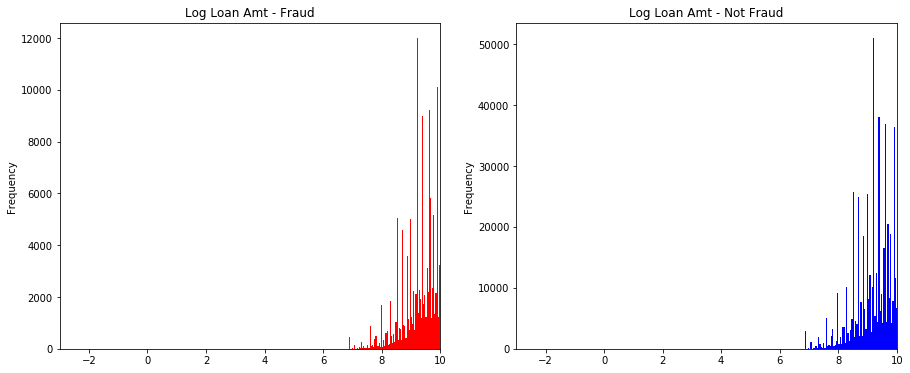
total = len(data_train)
total_amt = data_train.groupby(['isDefault'])['loanAmnt'].sum().sum()
plt.figure(figsize=(12,5))
plt.subplot(121)##1代表行,2代表列,所以一共有2个图,1代表此时绘制第一个图。
plot_tr = sns.countplot(x='isDefault',data=data_train)#data_train‘isDefault’这个特征每种类别的数量**
plot_tr.set_title("Fraud Loan Distribution \n 0: good user | 1: bad user", fontsize=14)
plot_tr.set_xlabel("Is fraud by count", fontsize=16)
plot_tr.set_ylabel('Count', fontsize=16)
for p in plot_tr.patches:
height = p.get_height()
plot_tr.text(p.get_x()+p.get_width()/2.,
height + 3,
'{:1.2f}%'.format(height/total*100),
ha="center", fontsize=15)
percent_amt = (data_train.groupby(['isDefault'])['loanAmnt'].sum())
percent_amt = percent_amt.reset_index()
plt.subplot(122)
plot_tr_2 = sns.barplot(x='isDefault', y='loanAmnt', dodge=True, data=percent_amt)
plot_tr_2.set_title("Total Amount in loanAmnt \n 0: good user | 1: bad user", fontsize=14)
plot_tr_2.set_xlabel("Is fraud by percent", fontsize=16)
plot_tr_2.set_ylabel('Total Loan Amount Scalar', fontsize=16)
for p in plot_tr_2.patches:
height = p.get_height()
plot_tr_2.text(p.get_x()+p.get_width()/2.,
height + 3,
'{:1.2f}%'.format(height/total_amt * 100),
ha="center", fontsize=15)

#转化成时间格式 issueDateDT特征表示数据日期离数据集中日期最早的日期(2007-06-01)的天数
data_train['issueDate'] = pd.to_datetime(data_train['issueDate'],format='%Y-%m-%d')
startdate = datetime.datetime.strptime('2007-06-01', '%Y-%m-%d')
data_train['issueDateDT'] = data_train['issueDate'].apply(lambda x: x-startdate).dt.days
#转化成时间格式
data_test_a['issueDate'] = pd.to_datetime(data_train['issueDate'],format='%Y-%m-%d')
startdate = datetime.datetime.strptime('2007-06-01', '%Y-%m-%d')
data_test_a['issueDateDT'] = data_test_a['issueDate'].apply(lambda x: x-startdate).dt.days
plt.hist(data_train['issueDateDT'], label='train');
plt.hist(data_test_a['issueDateDT'], label='test');
plt.legend();
plt.title('Distribution of issueDateDT dates');
#train 和 test issueDateDT 日期有重叠 所以使用基于时间的分割进行验证是不明智的

#透视图 索引可以有多个,“columns(列)”是可选的,聚合函数aggfunc最后是被应用到了变量“values”中你所列举的项目上。
pivot = pd.pivot_table(data_train, index=['grade'], columns=['issueDateDT'], values=['loanAmnt'], aggfunc=np.sum)
pivot
import pandas_profiling
pfr = pandas_profiling.ProfileReport(data_train)
pfr.to_file("./example.html")
数据探索性分析是我们初步了解数据,熟悉数据为特征工程做准备的阶段,甚至很多时候EDA阶段提取出来的特征可以直接当作规则来用。可见EDA的重要性,这个阶段的主要工作还是借助于各个简单的统计量来对数据整体的了解,分析各个类型变量相互之间的关系,以及用合适的图形可视化出来直观观察。希望本节内容能给初学者带来帮助,更期待各位学习者对其中的不足提出建议.
import pandas as pd
import numpy as np
import matplotlib.pyplot as plt
import seaborn as sns
import datetime
from tqdm import tqdm
from sklearn.preprocessing import LabelEncoder
from sklearn.feature_selection import SelectKBest
from sklearn.feature_selection import chi2
from sklearn.preprocessing import MinMaxScaler
import xgboost as xgb
import lightgbm as lgb
from catboost import CatBoostRegressor
import warnings
from sklearn.model_selection import StratifiedKFold, KFold
from sklearn.metrics import accuracy_score, f1_score, roc_auc_score, log_loss
warnings.filterwarnings('ignore')
data_train =pd.read_csv('../train.csv')
data_test_a = pd.read_csv('../testA.csv')
首先我们查找出数据中的对象特征和数值特征 。
numerical_fea = list(data_train.select_dtypes(exclude=['object']).columns)
category_fea = list(filter(lambda x: x not in numerical_fea,list(data_train.columns)))
label = 'isDefault'
numerical_fea.remove(label)
在比赛中数据预处理是必不可少的一部分,对于缺失值的填充往往会影响比赛的结果,在比赛中不妨尝试多种填充然后比较结果选择结果最优的一种; 比赛数据相比真实场景的数据相对要“干净”一些,但是还是会有一定的“脏”数据存在,清洗一些异常值往往会获得意想不到的效果.
把所有缺失值替换为指定的值0 。
data_train = data_train.fillna(0) 。
向用缺失值上面的值替换缺失值 。
data_train = data_train.fillna(axis=0,method='ffill') 。
纵向用缺失值下面的值替换缺失值,且设置最多只填充两个连续的缺失值 。
data_train = data_train.fillna(axis=0,method='bfill',limit=2) 。
#查看缺失值情况
data_train.isnull().sum()
#按照平均数填充数值型特征
data_train[numerical_fea] = data_train[numerical_fea].fillna(data_train[numerical_fea].median())
data_test_a[numerical_fea] = data_test_a[numerical_fea].fillna(data_train[numerical_fea].median())
#按照众数填充类别型特征
data_train[category_fea] = data_train[category_fea].fillna(data_train[category_fea].mode())
data_test_a[category_fea] = data_test_a[category_fea].fillna(data_train[category_fea].mode())
data_train.isnull().sum()
#查看类别特征
category_fea
['grade', 'subGrade', 'employmentLength', 'issueDate', 'earliesCreditLine']
#转化成时间格式
for data in [data_train, data_test_a]:
data['issueDate'] = pd.to_datetime(data['issueDate'],format='%Y-%m-%d')
startdate = datetime.datetime.strptime('2007-06-01', '%Y-%m-%d')
#构造时间特征
data['issueDateDT'] = data['issueDate'].apply(lambda x: x-startdate).dt.days
data_train['employmentLength'].value_counts(dropna=False).sort_index()
1 year 52489
10+ years 262753
2 years 72358
3 years 64152
4 years 47985
5 years 50102
6 years 37254
7 years 35407
8 years 36192
9 years 30272
< 1 year 64237
NaN 46799
Name: employmentLength, dtype: int64
def employmentLength_to_int(s):
if pd.isnull(s):
return s
else:
return np.int8(s.split()[0])
for data in [data_train, data_test_a]:
data['employmentLength'].replace(to_replace='10+ years', value='10 years', inplace=True)
data['employmentLength'].replace('< 1 year', '0 years', inplace=True)
data['employmentLength'] = data['employmentLength'].apply(employmentLength_to_int)
data['employmentLength'].value_counts(dropna=False).sort_index()
0.0 15989
1.0 13182
2.0 18207
3.0 16011
4.0 11833
5.0 12543
6.0 9328
7.0 8823
8.0 8976
9.0 7594
10.0 65772
NaN 11742
Name: employmentLength, dtype: int64
data_train['earliesCreditLine'].sample(5)
519915 Sep-2002
564368 Dec-1996
768209 May-2004
453092 Nov-1995
763866 Sep-2000
Name: earliesCreditLine, dtype: object
for data in [data_train, data_test_a]:
data['earliesCreditLine'] = data['earliesCreditLine'].apply(lambda s: int(s[-4:]))
# 部分类别特征
cate_features = ['grade', 'subGrade', 'employmentTitle', 'homeOwnership', 'verificationStatus', 'purpose', 'postCode', 'regionCode', \
'applicationType', 'initialListStatus', 'title', 'policyCode']
for f in cate_features:
print(f, '类型数:', data[f].nunique())
grade 类型数: 7
subGrade 类型数: 35
employmentTitle 类型数: 79282
homeOwnership 类型数: 6
verificationStatus 类型数: 3
purpose 类型数: 14
postCode 类型数: 889
regionCode 类型数: 51
applicationType 类型数: 2
initialListStatus 类型数: 2
title 类型数: 12058
policyCode 类型数: 1
像等级这种类别特征,是有优先级的可以labelencode或者自映射 。
for data in [data_train, data_test_a]:
data['grade'] = data['grade'].map({'A':1,'B':2,'C':3,'D':4,'E':5,'F':6,'G':7})
# 类型数在2之上,又不是高维稀疏的,且纯分类特征
for data in [data_train, data_test_a]:
data = pd.get_dummies(data, columns=['subGrade', 'homeOwnership', 'verificationStatus', 'purpose', 'regionCode'], drop_first=True)
在统计学中,如果一个数据分布近似正态,那么大约 68% 的数据值会在均值的一个标准差范围内,大约 95% 会在两个标准差范围内,大约 99.7% 会在三个标准差范围内.
def find_outliers_by_3segama(data,fea):
data_std = np.std(data[fea])
data_mean = np.mean(data[fea])
outliers_cut_off = data_std * 3
lower_rule = data_mean - outliers_cut_off
upper_rule = data_mean + outliers_cut_off
data[fea+'_outliers'] = data[fea].apply(lambda x:str('异常值') if x > upper_rule or x < lower_rule else '正常值')
return data
data_train = data_train.copy()
for fea in numerical_fea:
data_train = find_outliers_by_3segama(data_train,fea)
print(data_train[fea+'_outliers'].value_counts())
print(data_train.groupby(fea+'_outliers')['isDefault'].sum())
print('*'*10)
#删除异常值
for fea in numerical_fea:
data_train = data_train[data_train[fea+'_outliers']=='正常值']
data_train = data_train.reset_index(drop=True)
特征分箱的目的:
数据分桶的对象:
分箱的原因:
分箱的优点:
特别要注意一下分箱的基本原则:
当数值横跨多个数量级时,最好按照 10 的幂(或任何常数的幂)来进行分组:0 9、10 99、100 999、1000 9999,等等。固定宽度分箱非常容易计算,但如果计数值中有比较大的缺口,就会产生很多没有任何数据的空箱子.
#通过除法映射到间隔均匀的分箱中,每个分箱的取值范围都是loanAmnt/1000
data['loanAmnt_bin1'] = np.floor_divide(data['loanAmnt'], 1000)
##通过对数函数映射到指数宽度分箱
data['loanAmnt_bin2'] = np.floor(np.log10(data['loanAmnt']))
data['loanAmnt_bin3'] = pd.qcut(data['loanAmnt'], 10, labels=False)
for col in ['grade', 'subGrade']:
temp_dict = data_train.groupby([col])['isDefault'].agg(['mean']).reset_index().rename(columns={'mean': col + '_target_mean'})
temp_dict.index = temp_dict[col].values
temp_dict = temp_dict[col + '_target_mean'].to_dict()
data_train[col + '_target_mean'] = data_train[col].map(temp_dict)
data_test_a[col + '_target_mean'] = data_test_a[col].map(temp_dict)
# 其他衍生变量 mean 和 std
for df in [data_train, data_test_a]:
for item in ['n0','n1','n2','n2.1','n4','n5','n6','n7','n8','n9','n10','n11','n12','n13','n14']:
df['grade_to_mean_' + item] = df['grade'] / df.groupby([item])['grade'].transform('mean')
df['grade_to_std_' + item] = df['grade'] / df.groupby([item])['grade'].transform('std')
这里给出一些特征交互的思路,但特征和特征间的交互衍生出新的特征还远远不止于此,抛砖引玉,希望大家多多探索。请学习者尝试其他的特征交互方法.
#label-encode:subGrade,postCode,title
#高维类别特征需要进行转换
for col in tqdm(['employmentTitle', 'postCode', 'title','subGrade']):
le = LabelEncoder()
le.fit(list(data_train[col].astype(str).values) + list(data_test_a[col].astype(str).values))
data_train[col] = le.transform(list(data_train[col].astype(str).values))
data_test_a[col] = le.transform(list(data_test_a[col].astype(str).values))
print('Label Encoding 完成')
100%|██████████| 4/4 [00:08<00:00, 2.04s/it]
Label Encoding 完成
# 举例归一化过程
#伪代码
for fea in [要归一化的特征列表]:
data[fea] = ((data[fea] - np.min(data[fea])) / (np.max(data[fea]) - np.min(data[fea])))
特征选择的方法:
方差选择法 。
from sklearn.feature_selection import VarianceThreshold
#其中参数threshold为方差的阈值
VarianceThreshold(threshold=3).fit_transform(train,target_train)
相关系数法 。
from sklearn.feature_selection import SelectKBest
from scipy.stats import pearsonr
#选择K个最好的特征,返回选择特征后的数据
#第一个参数为计算评估特征是否好的函数,该函数输入特征矩阵和目标向量,
#输出二元组(评分,P值)的数组,数组第i项为第i个特征的评分和P值。在此定义为计算相关系数
#参数k为选择的特征个数
SelectKBest(k=5).fit_transform(train,target_train)
卡方检验 。
from sklearn.feature_selection import SelectKBest
from sklearn.feature_selection import chi2
#参数k为选择的特征个数
SelectKBest(chi2, k=5).fit_transform(train,target_train)
互信息法 。
from sklearn.feature_selection import SelectKBest
from minepy import MINE
#由于MINE的设计不是函数式的,定义mic方法将其为函数式的,
#返回一个二元组,二元组的第2项设置成固定的P值0.5
def mic(x, y):
m = MINE()
m.compute_score(x, y)
return (m.mic(), 0.5)
#参数k为选择的特征个数
SelectKBest(lambda X, Y: array(map(lambda x:mic(x, Y), X.T)).T, k=2).fit_transform(train,target_train)
from sklearn.feature_selection import RFE
from sklearn.linear_model import LogisticRegression
#递归特征消除法,返回特征选择后的数据
#参数estimator为基模型
#参数n_features_to_select为选择的特征个数
RFE(estimator=LogisticRegression(), n_features_to_select=2).fit_transform(train,target_train)
from sklearn.feature_selection import SelectFromModel
from sklearn.linear_model import LogisticRegression
#带L1惩罚项的逻辑回归作为基模型的特征选择
SelectFromModel(LogisticRegression(penalty="l1", C=0.1)).fit_transform(train,target_train)
from sklearn.feature_selection import SelectFromModel
from sklearn.ensemble import GradientBoostingClassifier
#GBDT作为基模型的特征选择
SelectFromModel(GradientBoostingClassifier()).fit_transform(train,target_train)
本数据集中我们删除非入模特征后,并对缺失值填充,然后用计算协方差的方式看一下特征间相关性,然后进行模型训练 。
# 删除不需要的数据
for data in [data_train, data_test_a]:
data.drop(['issueDate','id'], axis=1,inplace=True)
"纵向用缺失值上面的值替换缺失值"
data_train = data_train.fillna(axis=0,method='ffill')
x_train = data_train.drop(['isDefault','id'], axis=1)
#计算协方差
data_corr = x_train.corrwith(data_train.isDefault) #计算相关性
result = pd.DataFrame(columns=['features', 'corr'])
result['features'] = data_corr.index
result['corr'] = data_corr.values
# 当然也可以直接看图
data_numeric = data_train[numerical_fea]
correlation = data_numeric.corr()
f , ax = plt.subplots(figsize = (7, 7))
plt.title('Correlation of Numeric Features with Price',y=1,size=16)
sns.heatmap(correlation,square = True, vmax=0.8)
<matplotlib.axes._subplots.AxesSubplot at 0x12d88ad10>
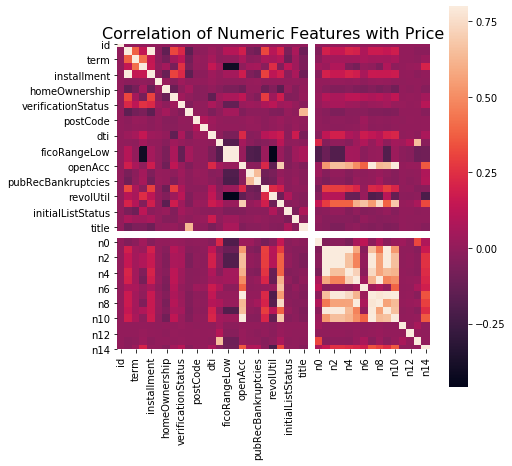
features = [f for f in data_train.columns if f not in ['id','issueDate','isDefault'] and '_outliers' not in f]
x_train = data_train[features]
x_test = data_test_a[features]
y_train = data_train['isDefault']
def cv_model(clf, train_x, train_y, test_x, clf_name):
folds = 5
seed = 2020
kf = KFold(n_splits=folds, shuffle=True, random_state=seed)
train = np.zeros(train_x.shape[0])
test = np.zeros(test_x.shape[0])
cv_scores = []
for i, (train_index, valid_index) in enumerate(kf.split(train_x, train_y)):
print('************************************ {} ************************************'.format(str(i+1)))
trn_x, trn_y, val_x, val_y = train_x.iloc[train_index], train_y[train_index], train_x.iloc[valid_index], train_y[valid_index]
if clf_name == "lgb":
train_matrix = clf.Dataset(trn_x, label=trn_y)
valid_matrix = clf.Dataset(val_x, label=val_y)
params = {
'boosting_type': 'gbdt',
'objective': 'binary',
'metric': 'auc',
'min_child_weight': 5,
'num_leaves': 2 ** 5,
'lambda_l2': 10,
'feature_fraction': 0.8,
'bagging_fraction': 0.8,
'bagging_freq': 4,
'learning_rate': 0.1,
'seed': 2020,
'nthread': 28,
'n_jobs':24,
'silent': True,
'verbose': -1,
}
model = clf.train(params, train_matrix, 50000, valid_sets=[train_matrix, valid_matrix], verbose_eval=200,early_stopping_rounds=200)
val_pred = model.predict(val_x, num_iteration=model.best_iteration)
test_pred = model.predict(test_x, num_iteration=model.best_iteration)
# print(list(sorted(zip(features, model.feature_importance("gain")), key=lambda x: x[1], reverse=True))[:20])
if clf_name == "xgb":
train_matrix = clf.DMatrix(trn_x , label=trn_y)
valid_matrix = clf.DMatrix(val_x , label=val_y)
params = {'booster': 'gbtree',
'objective': 'binary:logistic',
'eval_metric': 'auc',
'gamma': 1,
'min_child_weight': 1.5,
'max_depth': 5,
'lambda': 10,
'subsample': 0.7,
'colsample_bytree': 0.7,
'colsample_bylevel': 0.7,
'eta': 0.04,
'tree_method': 'exact',
'seed': 2020,
'nthread': 36,
"silent": True,
}
watchlist = [(train_matrix, 'train'),(valid_matrix, 'eval')]
model = clf.train(params, train_matrix, num_boost_round=50000, evals=watchlist, verbose_eval=200, early_stopping_rounds=200)
val_pred = model.predict(valid_matrix, ntree_limit=model.best_ntree_limit)
test_pred = model.predict(test_x , ntree_limit=model.best_ntree_limit)
if clf_name == "cat":
params = {'learning_rate': 0.05, 'depth': 5, 'l2_leaf_reg': 10, 'bootstrap_type': 'Bernoulli',
'od_type': 'Iter', 'od_wait': 50, 'random_seed': 11, 'allow_writing_files': False}
model = clf(iterations=20000, **params)
model.fit(trn_x, trn_y, eval_set=(val_x, val_y),
cat_features=[], use_best_model=True, verbose=500)
val_pred = model.predict(val_x)
test_pred = model.predict(test_x)
train[valid_index] = val_pred
test = test_pred / kf.n_splits
cv_scores.append(roc_auc_score(val_y, val_pred))
print(cv_scores)
print("%s_scotrainre_list:" % clf_name, cv_scores)
print("%s_score_mean:" % clf_name, np.mean(cv_scores))
print("%s_score_std:" % clf_name, np.std(cv_scores))
return train, test
def lgb_model(x_train, y_train, x_test):
lgb_train, lgb_test = cv_model(lgb, x_train, y_train, x_test, "lgb")
return lgb_train, lgb_test
def xgb_model(x_train, y_train, x_test):
xgb_train, xgb_test = cv_model(xgb, x_train, y_train, x_test, "xgb")
return xgb_train, xgb_test
def cat_model(x_train, y_train, x_test):
cat_train, cat_test = cv_model(CatBoostRegressor, x_train, y_train, x_test, "cat")
lgb_train, lgb_test = lgb_model(x_train, y_train, x_test)
************************************ 1 ************************************
Training until validation scores don't improve for 200 rounds
[200] training's auc: 0.749225 valid_1's auc: 0.729679
[400] training's auc: 0.765075 valid_1's auc: 0.730496
[600] training's auc: 0.778745 valid_1's auc: 0.730435
Early stopping, best iteration is:
[455] training's auc: 0.769202 valid_1's auc: 0.730686
[0.7306859913754798]
************************************ 2 ************************************
Training until validation scores don't improve for 200 rounds
[200] training's auc: 0.749221 valid_1's auc: 0.731315
[400] training's auc: 0.765117 valid_1's auc: 0.731658
[600] training's auc: 0.778542 valid_1's auc: 0.731333
Early stopping, best iteration is:
[407] training's auc: 0.765671 valid_1's auc: 0.73173
[0.7306859913754798, 0.7317304414673989]
************************************ 3 ************************************
Training until validation scores don't improve for 200 rounds
[200] training's auc: 0.748436 valid_1's auc: 0.732775
[400] training's auc: 0.764216 valid_1's auc: 0.733173
Early stopping, best iteration is:
[386] training's auc: 0.763261 valid_1's auc: 0.733261
[0.7306859913754798, 0.7317304414673989, 0.7332610441015461]
************************************ 4 ************************************
Training until validation scores don't improve for 200 rounds
[200] training's auc: 0.749631 valid_1's auc: 0.728327
[400] training's auc: 0.765139 valid_1's auc: 0.728845
Early stopping, best iteration is:
[286] training's auc: 0.756978 valid_1's auc: 0.728976
[0.7306859913754798, 0.7317304414673989, 0.7332610441015461, 0.7289759386807912]
************************************ 5 ************************************
Training until validation scores don't improve for 200 rounds
[200] training's auc: 0.748414 valid_1's auc: 0.732727
[400] training's auc: 0.763727 valid_1's auc: 0.733531
[600] training's auc: 0.777489 valid_1's auc: 0.733566
Early stopping, best iteration is:
[524] training's auc: 0.772372 valid_1's auc: 0.733772
[0.7306859913754798, 0.7317304414673989, 0.7332610441015461, 0.7289759386807912, 0.7337723979789789]
lgb_scotrainre_list: [0.7306859913754798, 0.7317304414673989, 0.7332610441015461, 0.7289759386807912, 0.7337723979789789]
lgb_score_mean: 0.7316851627208389
lgb_score_std: 0.0017424259863954693
testA_result = pd.read_csv('../testA_result.csv')
roc_auc_score(testA_result['isDefault'].values, lgb_test)
0.7290917729487896
特征工程是机器学习,甚至是深度学习中最为重要的一部分,在实际应用中往往也是所花费时间最多的一步。各种算法书中对特征工程部分的讲解往往少得可怜,因为特征工程和具体的数据结合的太紧密,很难系统地覆盖所有场景。本章主要是通过一些常用的方法来做介绍,例如缺失值异常值的处理方法详细对任何数据集来说都是适用的。但对于分箱等操作本章给出了具体的几种思路,需要读者自己探索。在特征工程中比赛和具体的应用还是有所不同的,在实际的金融风控评分卡制作过程中,由于强调特征的可解释性,特征分箱尤其重要.
数据挖掘专栏 。
数据挖掘实践(金融风控):金融风控之贷款违约预测挑战赛(上篇) 。
数据挖掘实践(金融风控):金融风控之贷款违约预测挑战赛(下篇) 。
最后此篇关于数据挖掘实践(金融风控):金融风控之贷款违约预测挑战赛(上篇)[xgboots/lightgbm/Catboost等模型]--模型融合:stacking、blending的文章就讲到这里了,如果你想了解更多关于数据挖掘实践(金融风控):金融风控之贷款违约预测挑战赛(上篇)[xgboots/lightgbm/Catboost等模型]--模型融合:stacking、blending的内容请搜索CFSDN的文章或继续浏览相关文章,希望大家以后支持我的博客! 。
数据挖掘实践(金融风控):金融风控之贷款违约预测挑战赛(上篇)[xgboots/lightgbm/Catboost等模型]--模型融合:stacking、blending 1.赛题简介

我是一名优秀的程序员,十分优秀!